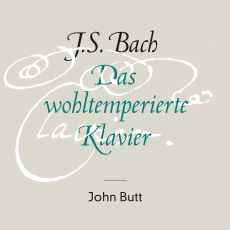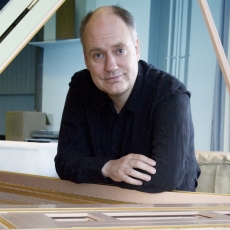John Butt - Bach WTC - International Record Review
Landmark Bach from John Butt
Any new release of Bach's '48' is bound to be a significant event, though I'd hazard a bet that John Butt's Olympian traversal is destined to be remembered as not so much a fixed point in the time continuum but as a significant and enduring musical landmark. Be under no illusions - this is a colossal and revelatory feat, and a major addition both to the current Bach discography and to contemporary performance scholarship.
These facts shouldn't surprise, of course. Perhaps best known as musical director of Edinburgh's Dunedin Consort, Butt also holds the Gardiner Chair as Professor of Music at the University of Glasgow, and is also well known as a solo harpsichordist. This new release is his first solo recording for Linn Records, with which he has forged an especially fertile alliance in recent years.
As Professor Butt reminds us in his illuminating booklet essay, these seminal works had a dual purpose, as witnessed, too, by Bach's note on the title page of Book 1, 'For the profit and use of musical youth desiring instruction, and especially for the pastime of those who are already skilled in this study.' The principal influence upon Das wohltemperierte Klavier was J. C. F. Fischer's set of 20 short preludes and fugues in chromatic order, Ariadne musica, of 1702. Several later German theorists (such as Johannes Mattheson) also produced short pieces in every key, but nothing on the scale of Bach's '48' had ever been undertaken before the completion of Book 1 in 1722.
As Butt explains, Bach's intentions were primarily didactic, just as the earlier Klavierbiichlein had the musical development of his eldest son Wilhelm Friedemann chiefly in mind. Writing of Book 2, however, which Bach finished in around 1742, Butt cautions that 'It would be a mistake to suggest that this is a mere 'overflow' from the earlier collection ... In all, Book II represents the largest and most varied collection of Bach's later years and reflects his increasing interest in the breadth of music history as he saw it.'
Despite Bach's necessarily circumscribed outlook, there is still an arresting universality of ambition about the set which readily translates into these vital and athletic performances. Two key features distinguish Butt's accounts consistently throughout these four extraordinary CDs. First, as is apparent right from the start of the first C major 'Prelude', Butt's approach to the music is unusually fluid, allowing plenty of room for spontaneous inflection and rubato within a very tightly controlled rhythmic framework, suggesting that Bach's own approach to playing his keyboard music might not have been quite as prosaic and four-square as some purists have chosen to present it.
Second, prepare to be bowled over time and again by the drive and muscular impulse attending these performances. The likes of Kenneth Gilbert's burnished refinement gives place to something that's altogether more stout and powerful, bringing an enervated clarity that's often suggestive of hearing this music played on the modern piano by Glenn Gould.
That invites comment on the instrument heard here. Some years ago, the Dunedin Consort commissioned a new harpsichord from the maker Bruce Kennedy, and the resulting copy of an early eighteenth-century German instrument by Michael Mietke proved to have rugged tonal characteristics and staying power that helped to catalyse this new recording in the first place. Butt immediately felt that this vigorous, full-bodied instrument would be an ideal vehicle on which to undertake the project, and the recordings were made in just four consecutive days at St Martin's Church, East Woodhay, Hampshire, in July 2013.
The occasion also marked the recording debut of the two recent scholarly editions employed here, Richard Jones's AB Edition of Book 1, and the new Henle publication, edited by Yo Tomita, of Book 2, each combining Bach's latest thoughts on these works. Another distinctive aspect of Butt's survey concerns tempo relationships between the individual preludes and associated fugues, and as he points out, 'history might inspire us to think of several dimensions simultaneously - say, pulse, notation, genre, mood, harmonic rhythm, range of note values - rather than aiming for a specific, ideal tempo. While we can never recreate the thought processes of another age, we may at least be able to share in some of the ways in which performers might have combined ideas and parameters.'
It would be an unending and probably pointless task to try to enumerate in detail the endless fascination and depth of insight afforded by these superlative performances. Yet the big-boned physicality of the music-making here, which proves so immersive as a listening experience overall, is in all probability the most overarching and defining feature of these impeccably wrought and glowingly recorded accounts.
To that extent, they stand on their own terms, as there is nothing in the catalogues which adopts anything like a comparable stance here. Practical elements of the music-making are always backed up by detailed scholarly insights, too, as with Butt's choice of fast but fluid tempos, which, he says, help us to appreciate 'how Bach viewed the physical. So often we think of Bach as a mind composer, but his music is very physical.'
As to rival performances, Richard Egarr's Harmonia Mundi recordings are also superlative, offering insights into the music that seem no less original. Though Egarr's view certainly doesn't offer such a wide expressive canvas, there's risk-taking at practically every turn in his eventful survey, and the recorded sound is powerful and immediate, yet without the natural bloom of the new Linn productions. Bargain hunters should be aware that the Brilliant Classics box devoted to Pieter-Jan Belder's nicely played survey is a snatch at the price, and decently recorded too. Better still, though, to splash out on John Butt's landmark traversal, which is in every way a tour de force.

